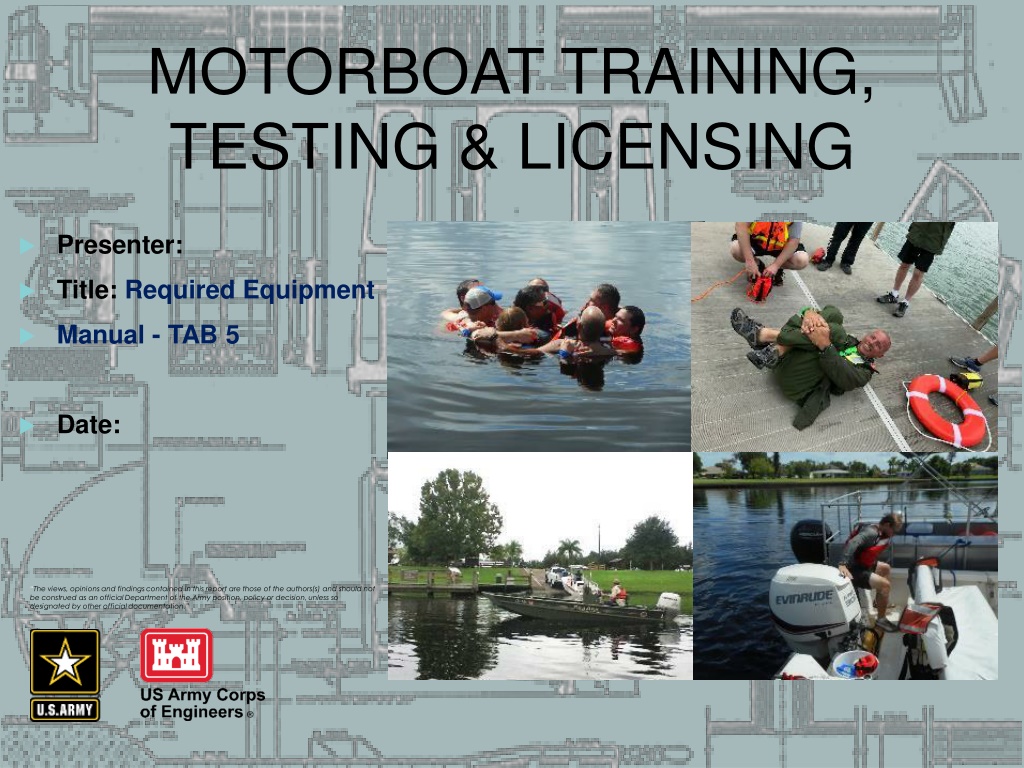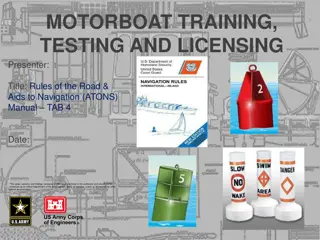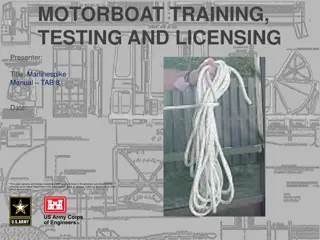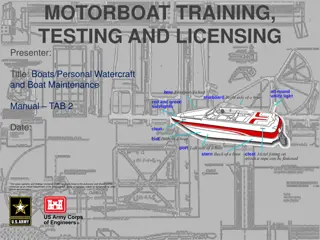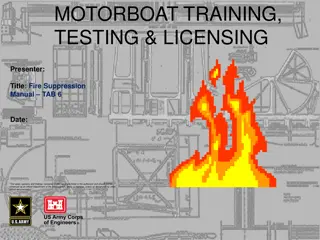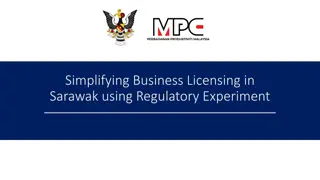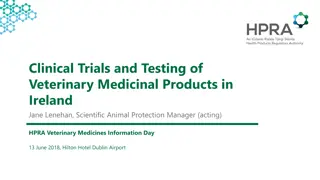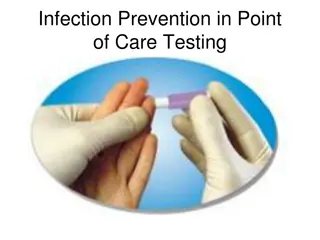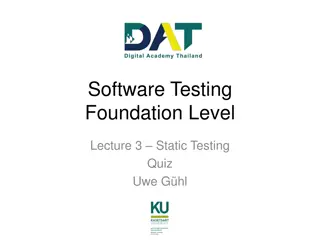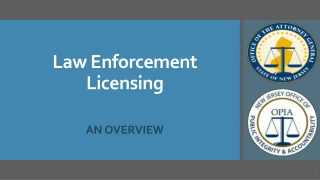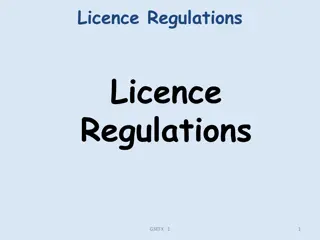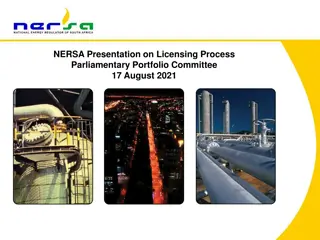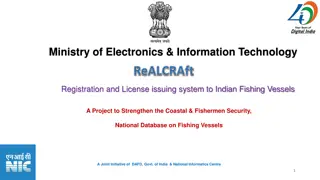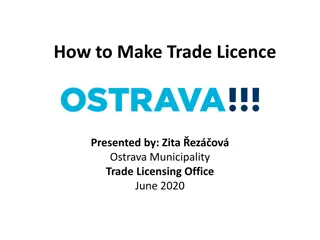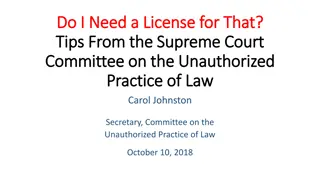Motorboat Training, Testing & Licensing Equipment Manual
This manual covers the requirements for licensing recreational vessels, focusing on safety equipment mandated by Federal laws and the US Army Corps of Engineers. It delves into the different vessel classes, their equipment requirements, and specifics like fire extinguisher regulations and types. Important information for ensuring safe boating practices and compliance with relevant regulations.
Download Presentation

Please find below an Image/Link to download the presentation.
The content on the website is provided AS IS for your information and personal use only. It may not be sold, licensed, or shared on other websites without obtaining consent from the author. Download presentation by click this link. If you encounter any issues during the download, it is possible that the publisher has removed the file from their server.
E N D
Presentation Transcript
MOTORBOAT TRAINING, TESTING & LICENSING Presenter: Title: Required Equipment Manual - TAB 5 Date: The views, opinions and findings contained in this report are those of the authors(s) and should not be construed as an official Department of the Army position, policy or decision, unless so designated by other official documentation.
2 Required Equipment 2 Objectives: Identify the two classes of recreational vessels you are licensing for Identify and describe the proper use and application of the required safety equipment that are required by Federal and State laws and the US Army Corps of Engineers Safety and Health Requirements Manual (EM 385-1-1) for these vessel classes.
3 Vessel Classes 3 CLASS A = vessels less than 16ft (4.9m) CLASS I = vessels 16ft to less than 26ft (4.9m 7.9m) Each class of vessel has minimum equipment requirements established by Federal law. Individual states and the Corps of Engineers also have specific equipment requirements for vessels under their jurisdiction.
4 4 Federal (United States Coast Guard (USCG)) State U.S. Army Corps of Engineers (EM 385-1-1)
5 Fire extinguisher requirements on recreational vessels (USCG) 1. Number of approved fire extinguishers depends upon the length and/or construction of the vessel. 2. Fire extinguishers are required on all recreational boats which have compartments and where explosive or flammable gases or vapors can be trapped. The following conditions require a fire extinguisher. a. Closed compartments where portable fuel tanks may be stored. b. Unsealed double-bottoms not completely filled with flotation material. c. Closed living spaces. d. Closed stowage compartment in which combustible or flammable materials are stowed. e. Permanently installed fuel tanks. A tank is permanent if it is secured in any way. If weight or location is such as to likely prevent someone from removing it in an emergency, the tank is considered permanent. 5
6 6 Fire Class & Fire Extinguisher Type Type of Extinguisher (Extinguishing Agent) Fuel Source Class of Fire Ordinary combustibles (e.g. trash, wood, paper, cloth) Water; chemical foam; dry chemical A Flammable liquids (e.g. oils, grease, tar, gasoline, paints, thinners) Carbon dioxide (CO2); halon; dry chemical; aqueous film forming foam (AFFF) B Electricity (e.g. live electrical equipment) CO2; halon; dry chemical C Dry powder (suitable for the specific combustible metal involved) Combustible metals (e.g. magnesium, titanium) D
7 Federal and State 7 Boat Length Without fixed system With fixed system None Less than 26 ft. USCG Approved, label will state similar to: Marine Type USCG Type B:C Size I Approval Number 162.028/EX2764 Valid Only With Bracket 817 Must be mounted in their specific marine type bracket in a readily accessible position Inspect monthly, replace as necessary 1 B-I
USCG PFD Requirements* 8 8 Class A Boats: On boats less than 16 feet in length there must be at least one WEARABLE PFD (Type I, II, III, or V) readily accessible for each person on board. Class I Boats: On boats 16 feet in length or longer there must be at least one WEARBLE PFD for each person on board plus at least one THROWABLE PFD (Type IV) immediately available. On any boat underway a child under the age of 13 must wear an appropriate USCG approved PFD unless they are below decks or in an enclosed cabin**. Georgia law is also under the age of 13. *33 CFR Part 175 established 2014 ** Individual State statutes for age requirement preempt USCG requirement
USCG PFD Requirements 9 9 Legibly Marked with its USCG Approval Number Good & Serviceable Condition Appropriate Size and type for the Intended Wearer Properly stowed
10 PFD Conditions cont d Adult (persons weighing 90 pounds or more) and capable of supporting a minimum of 25 pounds of buoyancy in fresh water for 48 hours Child (persons weighing less than 90 pounds) and capable of supporting a minimum of 16.5 pounds of buoyancy in fresh water for 48 hours Shall support the wearer in the water in an upright or slightly backward position, and shall provide support to the head so that the face of an unconscious or exhausted person is held above the water Shall be capable of turning the wearer, upon entering the water, to a safe flotation position as described above 10
11 STATISTICS % OF FATALITIES THAT DROWNED 11 YEAR TOTAL FATALITIES % OF FATALITIES THAT DROWNED WHO WERE NOT WEARING A PFD 84% 88% 84% 85% 84% 84% 85% 83% 84.5% 84% 2009 2010 2011 2012 2013 2014 2015 2016 2017 2018 683 639 697 651 560 610 626 701 658 633 75% 75% 70% 71% 77% 78% 76% 80% 76% 77% Where length was known, 80% of drownings were on boats less than 21 feet in length and where instruction was known, 74% of the operators did not receive boating safety instruction
12 PFD Buoyancy 12 How can a WEARABLE PFD with 25 pounds of buoyancy hold up a two hundred fifty pound person in the water? You have to do the math! Approximately 80% of the body is water. Water in the body has no weight in water. 250 lbs. X 80% = 200 lbs. 250 lbs. - 200 lbs. = 50 lbs. So now we are down to having to support only 50 pounds. But the PFD only has a buoyancy rating of 25 lbs. How can it hold up 50 lbs? On average our bodies also have 15% fat and fat is lighter than water. 250 lbs. X 15% = 37.5 lbs. 50 lbs. 37.5 lbs. = 12.5 lbs. Now you can see that the average 250 pound person weighs about 12.5 pounds in water. The 25 lbs. of buoyancy in the PFD is more than enough to keep the person afloat.
13 PFD Accessories 13 Knife Signal mirror Whistle Flashlight Waterproof meteor flares Strobe light Anything that will help people find you, keep you alive, keep you afloat.
14 Visual Distress Signals (VDS) Requirements Pyrotechnic 3 day and 3 night devices or 3 combination day/night Non-pyrotechnic 1 day and 1 night device Any combination so long as the minimum number per type is carried (Expired signals may be carried as extra equipment but are not counted toward meeting the VDS requirement) Vessel Requirements Class A night signals when operating between sunset and sunrise on any waters and on required waters Class I day/night signals at all times on required waters and night signals when operating any waters between sunset and sunrise Required waters: Coastal waters, the Great Lakes, territorial seas, and those waters connected directly to them, up to a point where a body of water is less than two miles wide. 14
15 Pyrotechnic VDS 15 Must be Coast Guard approved In serviceable condition Readily accessible Flare Pistols, Hand-held Red Flares and Orange Smoke Flares
16 Non-Pyrotechnic VDS 16 Must be Coast Guard approved In serviceable condition Readily accessible Orange Distress Flag and an Electric Distress Light
17 Sound Producing Device 17 Class A and Class I Vessels * some means of making an efficient sound signal (4-6 second blast) audible for mile *Not required on Georgia State waters but highly recommended
18 Navigation Lights 18 Required to be displayed from sunset to sunrise and in restricted visibility Tell other boaters Type of vessel you are Size of vessel you are Direction (movement) of your vessel Any Work you are performing
19 Navigation Lights 19 Power-driven - Classes A and I Must display Masthead light (225 , 2 miles) Stern light (135 , 2 miles) Red and Green sidelights (112.5 ,1 mile) OR May Display 360 degree all around white light (2 miles) Red and green sidelights (112.5 , 1 mile)
20 Anchored Vessels Night All around white light visible for two miles Exception, USCG) Vessels less than 23 ft/7 m are not required to display anchor lights unless anchored in or near a narrow channel, fairway or anchorage, or where other vessels normally navigate. Georgia law all vessels moored or anchored outside a designated mooring area during hours of darkness must display this light 20
21 Diver Down Flag 21 Diver Down Flag Red & White Protect Divers/Snorkelers 15 inches x 15 inches (GA) Safety Zone - 100 Feet (GA) Required on State waters Alpha Dive Flag White & Blue Protect Vessel No Less Than 1 meter in height Required on Federally controlled waters Both flags must be displayed rigidly
Additional Safety and Emergency Equipment 22 22 Anchor and line Tow line and bridle Marine Radio Mooring lines Boat hook Bilge pump(s) Rescue line Paddle Compass Tool kit First aid kit Navigation kit GPS Nautical Chart Hand-held light Additional PFD s In the world according to Art, these would be required equipment
Personnel Protective Equipment (29 CFR 1910.132) EYE PROTECTION Clear/tinted, impact rated FOOTWEAR Non-skid/scuffing, cushioning, insulation HEARING PROTECTION Ear muffs/plugs U.V. RAY PROTECTION Sun block, clothing 23 23
24 24 Questions to this Point?
25 25 Corps of Engineer Reqmts: Government operators shall be licensed & certified in accordance with ER 385-1-91 EM 385-1-1 01A.15.a. An AHA shall be prepared and documented as warranted by the hazards associated with the activity 03.B.01 b. First Aid Kit - TYPE III, 16 unit (reference Table 3-1 for contents) 05.J.01 Inherently buoyant Type III, Type V work vests, or better USCG-approved personal flotation devices (PFDs) shall be provided and properly worn (zipped, tied, latched, etc., in closed fashion) by all persons in the following circumstances: a. On floating pipelines, pontoons, rafts, or stages; b. On structures or equipment extending over or next to water except where guardrails, personal fall protection system, or safety nets are provided for employees; c. Working alone at night where there are drowning hazards, regardless of other safeguards provided; d. In skiffs, small boats, or launches, unless in an enclosed cabin or cockpit; or e. Whenever there is a drowning hazard.
26 26 05.J.02 Automatic-Inflatable PFD s Type V or better, USCG approved for commercial use, may be worn by workers in lieu of inherently buoyant PFD s (see conditions 05.J.01 a- e above) provided the following criteria are met: Over 16 years old and weigh 90 lbs or more. An Activity Hazard Analysis (AHA) shall be developed and used to select the most appropriate PFD for the activity PFD s must be inspected, maintained per manufacturer s instructions. PFD s for construction, maintenance, hot work must be designed for that activity. The standard commercial auto- inflatable PFD does not meet these requirements Provide minimum 30 lbs. of buoyancy & have a status indicator window Personal shall be trained in the use, maintenance, restrictions, care, storage, inspection, and post-deployment procedures per manufacturer s instructions. In water testing is required for all first time users so that wearers become familiar with the feel and performance of the PFD Must be worn
27 27 05.J.03 All wearable PFD s shall be of an international orange (or orange/red) or ANSI 107 yellow green color. a. Each inherently buoyant PFD shall have at least 31 sq. in. (200 sq. cm.) of retro-reflective material attached to its front side and at least 31 sq. in. (200 sq. cm.) on its back side per USCG requirements (46 CFR Part 25.25-15). b. Each auto-inflatable PFD shall have at least 31 sq. in. (200 sq. cm.) of retro-reflective material attached to its front side and at least 31 sq. in. (200 sq. cm.) on its bladder, to be visible when deployed (with the exception of Work Vests which are allowed to have a total of 31 sq. in. front and back combined)
28 28 05.J.04 Each PFD shall be equipped with a USCG-approved automatically activated light. Lights are not required for PFDs on projects performed exclusively during daylight hours. 05.J.06 d. Ring Buoys (min 20 diameter) shall be USCG-approved & have at least 90 ft. of 3/8 in. solid braid polypropylene, or equivalent, attached. Throw bags and TYPE IV cushions may be used in addition to ring buoys. Ring buoys and line shall be inspected at a minimum of every six months and stored in such a manner to allow immediate deployment and be protected from degradation from weather and sunlight 19.A.05 a. Fenders shall be provided to prevent damage and sparking and to provide safe areas for workers exposed to pinching situations
29 29 19.A.05 c. Signal Devices (lights, sound devices, VDS, etc.) shall be provided on all vessels to give signals required by the navigation rules applicable to the waters on which the vessel is operated on. 19.B.04 a. (1) At least one portable or permanent ladder of sufficient length to allow a person to self rescue by boarding the ladder from the water (2) Other methods or means designed to assist in the rescue of an incapacitated person overboard
30 19.F.02 d. All open cabin launches or motorboats shall be equipped with kill (dead man) switches . CESAD-PDO Policy Memorandum 385- 18-1 dated 28 May 2018, requires testing of kill switch, operator tethered to kill switch via lanyard and spare lanyard be kept on motorboats 19.F.03 a. The minimum number and rating of fire extinguisher that shall be carried on Class A and Class I motorboats: One -1A:10BC This extinguisher contains agents equivalent to 1.25 gallons of water for a Class A fire, extinguish 10 square feet of a Class B fire and can be used on a Class C fire 19.F.03 b. All motorboats having gasoline or liquid petroleum gas in cabins, compartments or confined spaces shall be equipped with an automatic CO2 fire extinguishing system 30
31 31 19.F.04 Float Plans shall be prepared by the operator when engaged in surveying, patrolling or inspection activities that are remote and expected to take longer than four hours or when travelling alone. The plan shall be filed with the operators supervisor and at a minimum contain the following: Vessel information Personnel on board Activity to be performed Expected departure, route and time of return Means of communication
32 19.F.05 All Corps of Engineers motorboat operators shall complete and document the following training: a. A boating safety course meeting the criteria of the USCG Auxiliary, National Association of State Boating Law Administrators (NASBLA), or equivalent; and b. Motorboat handling training, based on the types of boats they will operate, provided by qualified instructors (in-house or other). Operators must pass a written and operational test. c. Current USCG licensed personnel are exempt from the boating safety training, but they shall complete the written exam and operational test; d. Government employees shall complete a USACE- approved 24-hour initial boating safety course and 8-hour refresher as prescribed in ER 385-1-91. Both initial and refresher courses require the 100 yard swim with PFD and self-rescue 32
33 REVIEW 33 What are the two vessel classes and associated lengths we are licensing for? Name the four fire classes and the materials they are comprised of? What is the weight to determine if a wearable PFD is classified as an adult or child PFD? All-around white lights must be visible for what distance? How can navigation lights be displayed on Class A and Class I vessels? How long is an efficient sound signal? What is the minimum number of pyrotechnic VDS required? What is the COE requirement for fire extinguishers? What is the COE age and weight to be able to wear an auto-inflatable PFD? What is the minimum buoyancy requirement for a COE auto inflatable PFD? The COE requires what type of first aid kit? Name five other COE equipment requirements besides first aid kit, PFD s or fire extinguisher?
